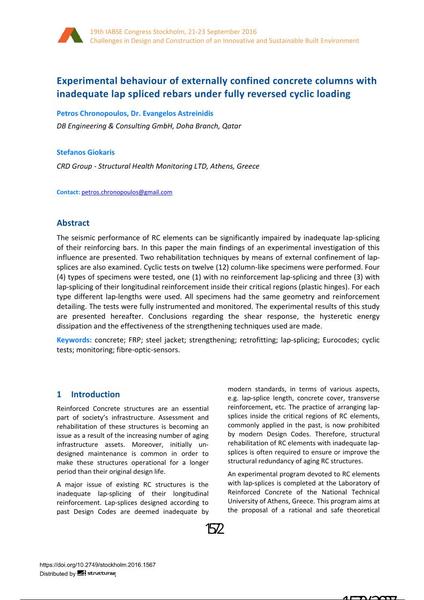Experimental behaviour of externally confined concrete columns with inadequate lap spliced rebars under fully reversed cyclic loading

|
|
|||||||||||
Détails bibliographiques
| Auteur(s): |
Petros Chronopoulos
(DB Engineering & Consulting GmbH, Doha Branch, Qatar)
Evangelos Astreinidis (DB Engineering & Consulting GmbH, Doha Branch, Qatar) Stefanos Giokaris (CRD Group - Structural Health Monitoring LTD, Athens, Greece) |
||||
|---|---|---|---|---|---|
| Médium: | papier de conférence | ||||
| Langue(s): | anglais | ||||
| Conférence: | IABSE Congress: Challenges in Design and Construction of an Innovative and Sustainable Built Environment, Stockholm, Sweden, 21-23 September 2016 | ||||
| Publié dans: | IABSE Congress Stockholm, 2016 | ||||
|
|||||
| Page(s): | 1572-1579 | ||||
| Nombre total de pages (du PDF): | 8 | ||||
| Année: | 2016 | ||||
| DOI: | 10.2749/stockholm.2016.1567 | ||||
| Abstrait: |
The seismic performance of RC elements can be significantly impaired by inadequate lap-splicing of their reinforcing bars. In this paper the main findings of an experimental investigation of this influence are presented. Two rehabilitation techniques by means of external confinement of lap- splices are also examined. Cyclic tests on twelve (12) column-like specimens were performed. Four (4) types of specimens were tested, one (1) with no reinforcement lap-splicing and three (3) with lap-splicing of their longitudinal reinforcement inside their critical regions (plastic hinges). For each type different lap-lengths were used. All specimens had the same geometry and reinforcement detailing. The tests were fully instrumented and monitored. The experimental results of this study are presented hereafter. Conclusions regarding the shear response, the hysteretic energy dissipation and the effectiveness of the strengthening techniques used are made. |
||||
| Mots-clé: |
béton renforcement
|
||||
